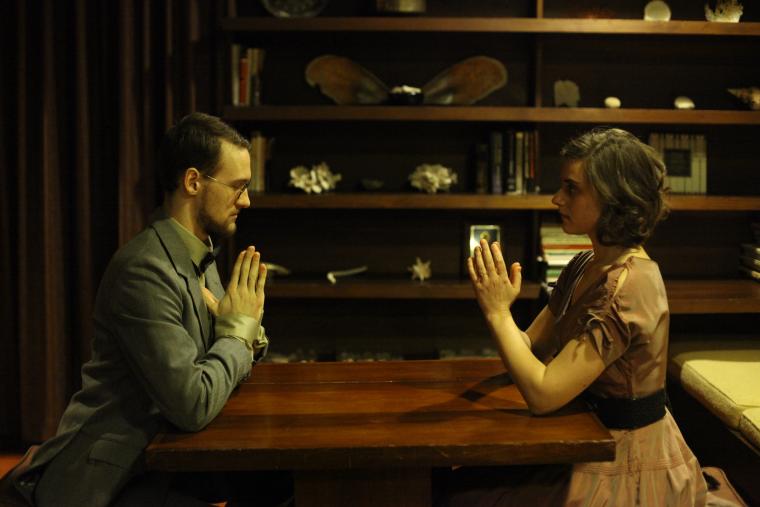A Haunting House
April 4, 2014
James Helmsworth

Linus Ignatius ’14 with his co-star and the assistant director of House, Julia Melfi ’15.
Photo credit: Linus Ignatius '14
Student Profile: Linus Ignatius ’14House begins quietly, with a smooth stream of graham crackers and fruit punch, served by a plucky wait staff. By the end, as the cast escorts its audience across a snowy yard, away from the titular home, glowing bright against the night sky, something far more sinister sits in the stomachs of the attendees.
Directed by Linus Ignatius ’14, House ran from March 5-9th in Weltzheimer/Johnson House, a home designed by Frank Lloyd Wright and owned by the Oberlin College, which regularly opens it for tour. House tells the story of a prodigal son, played by Ignatius, who has returned to his hometown. He hosts a dinner party for some of the town's residents, who are quietly investigating him to see if he'll be able to fit back in. Throughout the course of the night, smiles and pleasantries give way to deceit and terror. As Ignatius puts it, House shows a "dazzling dance of hospitality flipping and becoming a nightmare."
The piece is entirely immersive, casting its audience as attendees at the party who watch the events unfold in the house. Throughout the play, they're yanked into rooms by the cast, who squabble, scheme, and seduce each other. Some scenes are shown to the entire audience, while some actors mutter asides that only one audience member will hear. All is on display: the cast directs the audience to open drawers; and even into the bathroom, where characters splash water on their faces to awaken their senses and breakdown in tears in the shower.
House, which Ignatius developed during winter term as a capstone project for his theater major, was born out of his frustration with the rigidity of conventional theater, like the fixed nature of the script and the stark divide between the audience and the stage. After seeing Sleep No More, an immersive and mostly silent re-telling of Macbeth in a New York City warehouse, Ignatius realized as he puts it, "collapse that distance."
Though he expected difficulty in getting the college's permission to use the space, it proved to be just the opposite. Ignatius found an eager collaborator in Jason Trimmer, the Allen Memorial Art Museum's curator of education. "I was pretty darn nervous, but I had no reason to be because Trimmer leaps at the opportunity to share that space with any student who wants to collaborate, especially if you come to him far in advance and are perfectly open about the process."
After the casting process, Ignatius began putting the play together. He and his cast worked in the house for countless hours during winter term, improving scenes and putting a story together, based just on his dinner-party-gone-wrong concept and the energy of different rooms in the house. There was never a script; both the storyline and the characters come from the cast's improvisation under Ignatius's guiding hand, which gives the play its designation as "devised."
With scenes taking place in different rooms at the same time, Ignatius had to rely upon the unwavering support of assistant director and House co-star, third-year student Julia Melfi, to help him direct the cast. "I would have to run through the house and coordinate all these movements and have Julia help me out with that," he says. "Some of the scenes in the show I still haven't seen."
Ignatius says the cast is the finest he's worked with. "The professionalism that these students are exhibiting in this project is completely unparalleled," he says. "I have never been in a theater production where people have brought so much."
As he and the company drilled, they kept the specifics of House a secret. "Given that the whole show has this tone of investigation, how can you investigate if you already know what's going on?" Ignatius says. This sparked curiosity in Oberlin's student body, which turned into hype. When House tickets went on sale the week before the show, they sold out quickly.
Ignatius says that this enthusiasm for arts is part of what makes Oberlin a great place to create. In fact, House's immersive design requires an audience willing to throw themselves into the play. Asked to attend in formalwear, they help give the show its dinner-party feel. "If I didn't have a willing and intrigued audience here, the project would've been a bust, entirely," says Ignatius.
Those unable to snag a ticket have a chance to see it in the future, as Ignatius had House rehearsals and performances filmed, with the plan of cutting together a film later this year.
And according to those who know him, House fans will certainly have a chance to see more of Ignatius’s work in the future. "Linus is blessed with three hard-to-find qualities: he is an impeccable listener, fearless and has real talent," says Rian Brown-Orso, associate professor of cinema studies and new media. "The plurality of these qualities will ensure a long career. I feel lucky to have had him as a student."
House footage by Nico Hen ’14
You may also like…
Josh Nolan Named Vice President, General Counsel, and Secretary at Oberlin
Distinguished attorney brings extensive experience in higher education law.
Learning by Teaching: Oberlin Students Share Global Music with Young Learners
College and Conservatory students in PACE 103 prepare local children for an immersive community concert at Oberlin.
Nuiko Wadden ’02 Joins Oberlin Conservatory Faculty as Assistant Professor of Harp
The versatile musician brings extensive opera, orchestral, and contemporary music experience to her role


